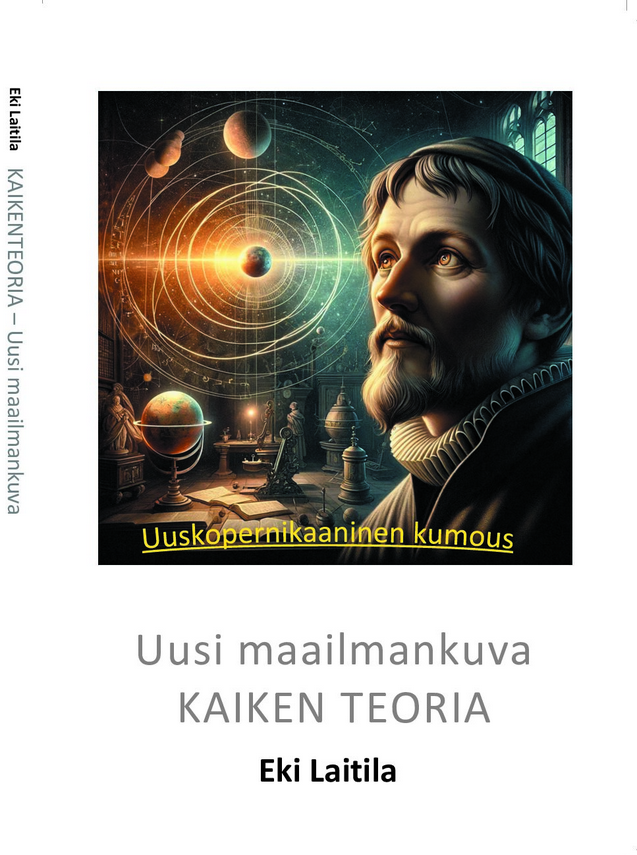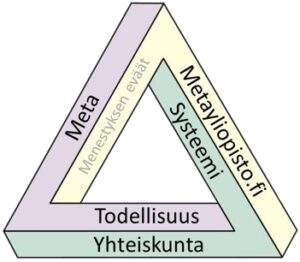Perustin Metayliopisto – sivuston vuonna 2016 korostamaan akateemisen, itsenäisen tutkimuksen merkitystä edistämään riippumatonta tiedettä, alkaen ohjelmisto-ongelmien ratkaisun metodiikasta, joka oli väitöskirjani aihe (v. 2008). Tutkimusfokus laajeni pian systeemiajatteluun, kybernetiikkaan ja lopulta tieteenfilosofiaan, josta tuloksena syntyi, kahdeksassa vuodessa, keväällä 2024 Kaikenteoria – kirja, aiemman viiden tiedekirjan jatkeeksi.
- Visio: Metayliopisto-foorumi edistää kaikkien tieteenalojen, systeemisyyden ja kybernetiikan ymmärrystä kokonaisvaltaisesti kestävän kehityksen ja yhteiskunnan holistisen edistymisen tueksi.
- Missiona on tarjota avoin ja monipuolinen foorumi tiedon jakamiseen ja uuden luomiseen, kunnioittaen tieteen monimuotoisuutta ja sen mahdollisuuksia vaikuttaa yhteiskuntaan.
- Arvot: foorumin visioon liittyvät kiinteästi visuaalisuus, symbolinen mallintaminen, IT-alan arkkitehtuurit ja metodiikat, totuusteoriat, ihanteellisuuden pohtiminen, moni- ja metatieteellisyys, avoin demokratia ja tiede sekä uusi tieteenfilosofia 2.0.
- Tunnuslauseet:
- “Everything is a System”.
- Tieto x Järki x Ymmärrys.
- Kaikki liittyy kaikkeen (Herakleitos).
- Et voi astua samaan virtaan kahdesti (Herakleitos).



Metayliopisto syntyi tavallaan vahingossa, vuonna 2016, internet-jakeluvälineeksi, ajatuksena luoda riippumatonta tutkimustietoa vallitsevan yliopistosysteemin ulkopuolella, ottamaan huomioon silloisen systeemin haasteet tulkita yhteiskuntaa. Ensimmäinen missio löytyy täältä.
Metayliopiston tarkoitus ei ole kahdeksassa (8) vuodessa juurikaan muuttunut, mikä kertoo valinnan toimivuudesta, mutta sisäinen kompetenssi on kehittynyt yhä laaja-alaisemmaksi tieteen ja monitieteellisyyden osaajaksi – kohti uutta käsitystä millaista tieteenteon tulisi olla.
English:
I founded the MetaUniversity website in 2016 to emphasize the importance of academic, independent research in promoting independent science, starting with the methodology of solving software problems, which was the topic of my doctoral dissertation (in 2008). The research focus soon expanded to systems thinking, cybernetics and finally philosophy of science, which resulted in the book Theory of Everything in 2024, a continuation of the previous five science books.
Vision: The MetaUniversity forum promotes the comprehensive understanding of all disciplines, systemicity and cybernetics in support of sustainable development and the holistic progress of society.
The mission is to provide an open and diverse forum for sharing knowledge and creating new things, respecting the diversity of science and its potential to impact society.
Values: the vision of the forum is closely related to visuality, symbolic modeling, IT architectures and methodologies, truth theories, consideration of ideality, multi- and meta-disciplinarity, open democracy and science, and the new philosophy of science 2.0.
Some of our slogans are:
- “Everything is a System”.
- Knowledge x Reason x Understanding.
- Everything is connected to everything (Heraclitus).
- You cannot step into the same stream twice (Heraclitus).
